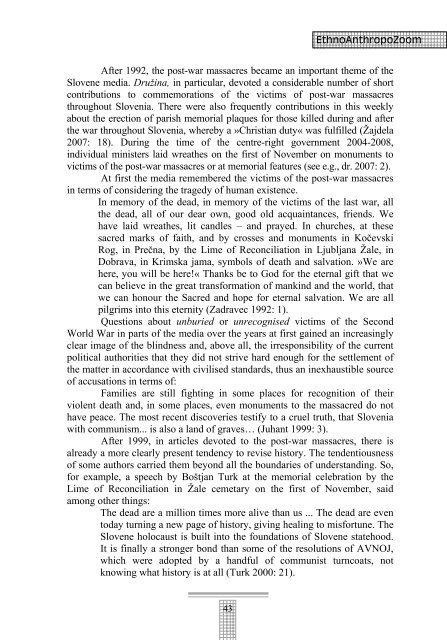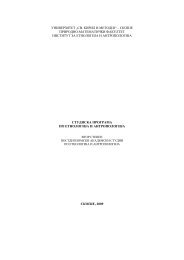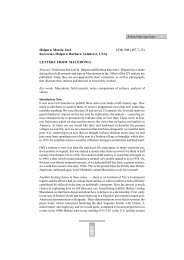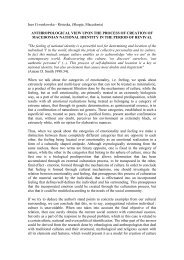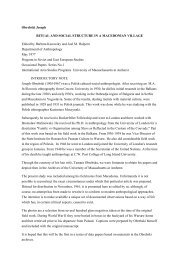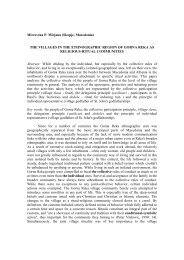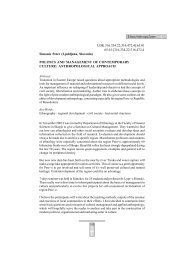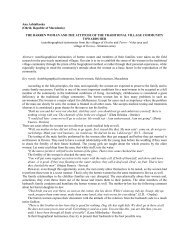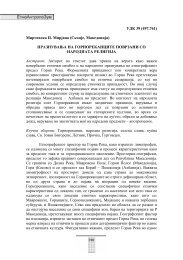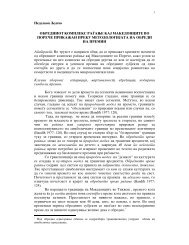Jezernik, Bozidar (Slovenia), The Red and the Black
Jezernik, Bozidar (Slovenia), The Red and the Black
Jezernik, Bozidar (Slovenia), The Red and the Black
You also want an ePaper? Increase the reach of your titles
YUMPU automatically turns print PDFs into web optimized ePapers that Google loves.
EthnoAnthropoZoom<br />
After 1992, <strong>the</strong> post-war massacres became an important <strong>the</strong>me of <strong>the</strong><br />
Slovene media. Družina, in particular, devoted a considerable number of short<br />
contributions to commemorations of <strong>the</strong> victims of post-war massacres<br />
throughout <strong>Slovenia</strong>. <strong>The</strong>re were also frequently contributions in this weekly<br />
about <strong>the</strong> erection of parish memorial plaques for those killed during <strong>and</strong> after<br />
<strong>the</strong> war throughout <strong>Slovenia</strong>, whereby a »Christian duty« was fulfilled (Žajdela<br />
2007: 18). During <strong>the</strong> time of <strong>the</strong> centre-right government 2004-2008,<br />
individual ministers laid wrea<strong>the</strong>s on <strong>the</strong> first of November on monuments to<br />
victims of <strong>the</strong> post-war massacres or at memorial features (see e.g., dr. 2007: 2).<br />
At first <strong>the</strong> media remembered <strong>the</strong> victims of <strong>the</strong> post-war massacres<br />
in terms of considering <strong>the</strong> tragedy of human existence.<br />
In memory of <strong>the</strong> dead, in memory of <strong>the</strong> victims of <strong>the</strong> last war, all<br />
<strong>the</strong> dead, all of our dear own, good old acquaintances, friends. We<br />
have laid wrea<strong>the</strong>s, lit c<strong>and</strong>les – <strong>and</strong> prayed. In churches, at <strong>the</strong>se<br />
sacred marks of faith, <strong>and</strong> by crosses <strong>and</strong> monuments in Kočevski<br />
Rog, in Prečna, by <strong>the</strong> Lime of Reconciliation in Ljubljana Žale, in<br />
Dobrava, in Krimska jama, symbols of death <strong>and</strong> salvation. »We are<br />
here, you will be here!« Thanks be to God for <strong>the</strong> eternal gift that we<br />
can believe in <strong>the</strong> great transformation of mankind <strong>and</strong> <strong>the</strong> world, that<br />
we can honour <strong>the</strong> Sacred <strong>and</strong> hope for eternal salvation. We are all<br />
pilgrims into this eternity (Zadravec 1992: 1).<br />
Questions about unburied or unrecognised victims of <strong>the</strong> Second<br />
World War in parts of <strong>the</strong> media over <strong>the</strong> years at first gained an increasingly<br />
clear image of <strong>the</strong> blindness <strong>and</strong>, above all, <strong>the</strong> irresponsibility of <strong>the</strong> current<br />
political authorities that <strong>the</strong>y did not strive hard enough for <strong>the</strong> settlement of<br />
<strong>the</strong> matter in accordance with civilised st<strong>and</strong>ards, thus an inexhaustible source<br />
of accusations in terms of:<br />
Families are still fighting in some places for recognition of <strong>the</strong>ir<br />
violent death <strong>and</strong>, in some places, even monuments to <strong>the</strong> massacred do not<br />
have peace. <strong>The</strong> most recent discoveries testify to a cruel truth, that <strong>Slovenia</strong><br />
with communism... is also a l<strong>and</strong> of graves… (Juhant 1999: 3).<br />
After 1999, in articles devoted to <strong>the</strong> post-war massacres, <strong>the</strong>re is<br />
already a more clearly present tendency to revise history. <strong>The</strong> tendentiousness<br />
of some authors carried <strong>the</strong>m beyond all <strong>the</strong> boundaries of underst<strong>and</strong>ing. So,<br />
for example, a speech by Boštjan Turk at <strong>the</strong> memorial celebration by <strong>the</strong><br />
Lime of Reconciliation in Žale cemetary on <strong>the</strong> first of November, said<br />
among o<strong>the</strong>r things:<br />
<strong>The</strong> dead are a million times more alive than us ... <strong>The</strong> dead are even<br />
today turning a new page of history, giving healing to misfortune. <strong>The</strong><br />
Slovene holocaust is built into <strong>the</strong> foundations of Slovene statehood.<br />
It is finally a stronger bond than some of <strong>the</strong> resolutions of AVNOJ,<br />
which were adopted by a h<strong>and</strong>ful of communist turncoats, not<br />
knowing what history is at all (Turk 2000: 21).<br />
43


